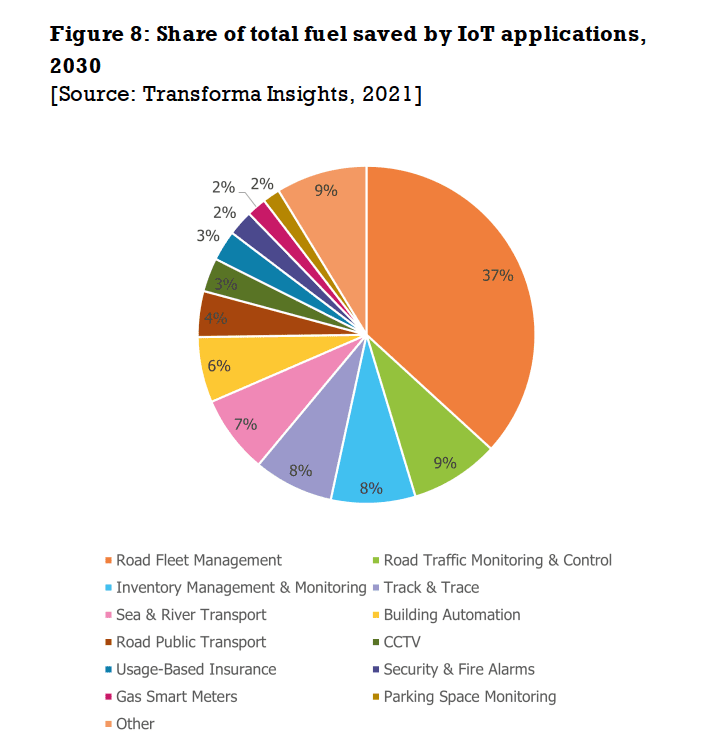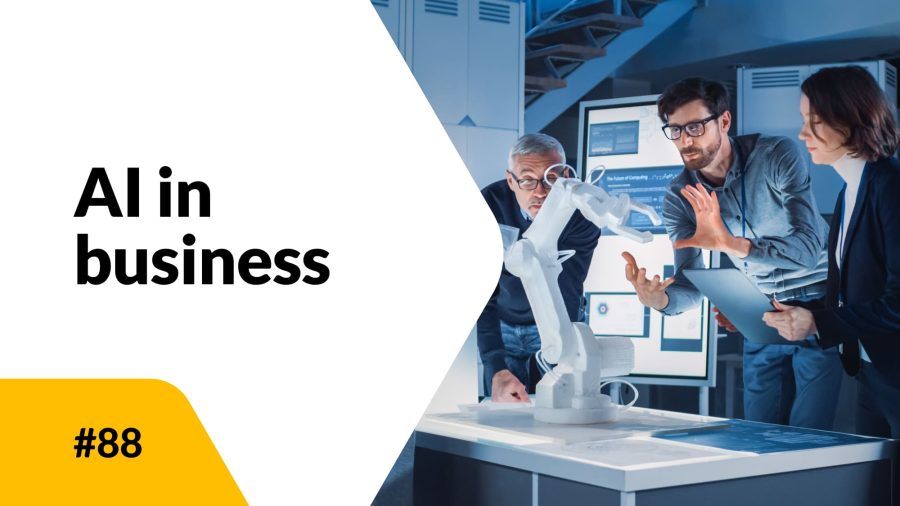IoT - table of contents
What is the Internet of Things? (IoT)
The Internet of Things, also known as IoT, is a technology that enables the connection and exchange of data between various devices connected to the Internet. It is a network of physical objects – “things” – equipped with sensors, software, and technologies that allow them to exchange data with other devices and systems over the internet. But why connect all devices to the Internet – from printers and refrigerators to air conditioners, trucks, and industrial machines?
Research conducted by Transforma Insights indicates that the production of new IoT devices will increase global electricity consumption by 34 terawatt-hours (TWh) by 2030. Meanwhile, training and using large language models, such as ChatGPT, may lead data centers to draw up to 21% of the world’s electricity demand.
However, Internet of Things solutions will also reduce electricity consumption compared to using the same type of sensor-less devices by over 1.6 petawatt-hours (PWh). To illustrate the scale – that’s the amount of electricity needed to cover the consumption of over 136.5 million homes for one year. Businesses, however, cannot thrive without increasingly new devices, and artificial intelligence can greatly assist in further minimizing the energy they consume.

Source: Transforma Insights (https://www.6gworld.com/)
What is the connection between IoT and AI?
Artificial Intelligence analyzes data from Internet of Things devices, identifying trends and strategies to save energy. Thanks to this, IoT and AI open up new possibilities for efficiently managing energy consumption. For example, AI can adjust Heating, Ventilation, and Air Conditioning (HVAC) systems based on:
- patterns of room usage – for instance, lowering the temperature in an unoccupied room on a given day,
- weather conditions – reducing the air conditioner power on a cloudy or windy day,
- indoor air quality – increasing ventilation efficiency only during a meeting involving many people.
Additionally, AI supported by IoT enables the creation of digital twins to optimize manufacturing processes, such as predicting machine part consumption or analyzing the frequency and causes of failures leading to downtime.
IoT AI technologies are beneficial for the entire electricity supply chain – consumers, distributors, and power plants. Internet of Things allows the automation of various processes, such as collecting energy data for measurements and analysis. The application of hardware power constraints and the optimization of AI model training time can reduce energy consumption by approximately 12% to 15% with minimal impact on model performance.
How can IoT and AI reduce energy costs in your company?
IoT sensors in buildings send real-time energy consumption data for analysis, speeding up repairs and reducing energy losses due to faulty equipment. Here are examples of sensors that can be installed in buildings:
- temperature sensors – monitor temperature changes in rooms and allow for optimizing energy consumption for heating or cooling,
- light sensors – detect the level of natural light and automatically adjust the intensity of artificial lighting,
- motion sensors – enable system activation only when people are present in the room, reducing unnecessary energy consumption,
- smart meters – collect data on energy consumption, enabling detailed analysis and optimization,
- air quality sensors – regulate the operation of ventilation systems, ensuring proper air quality with minimal energy consumption.
Smart thermostats and lighting systems can adapt to room usage patterns, reducing energy costs. IoT devices can decrease electricity consumption and costs in buildings during peak hours through demand response programs and scheduling. Implementing IoT and AI-based solutions can lead to energy savings of up to 40%. Furthermore, AI-controlled energy storage solutions optimize its use by managing storage and distribution.

Source: DALL·E 3, prompt: Marta M. Kania (https://www.linkedin.com/in/martamatyldakania/)
Benefits of using IoT and AI
Introducing intelligent IoT and AI technologies brings many benefits. It’s not just a way to lower bills but also to enhance the comfort of office use, primarily:
- better temperature control and energy savings thanks to smart thermostats,
- control of lighting brightness, which means a significant reduction in electricity consumption, especially during the autumn-winter period,
- air humidity management – particularly important when storing documents or sensitive, specialized equipment.
IoT devices are also becoming increasingly sophisticated, and in response to growing demand, sensor prices are decreasing. An example is Flex2X, a solution created by the British company Grid Edge (https://gridedge.ai/). This system integrates information from already installed sensors in buildings, such as temperature or humidity detectors, with additional data, such as weather conditions. It then analyzes them using AI algorithms, continuously optimizing energy utilization in the building.

Source: DALL·E 3, prompt: Marta M. Kania (https://www.linkedin.com/in/martamatyldakania/)
Downsides of IoT – how much energy does AI require?
Unfortunately, the combination of Internet of Things and AI comes with its drawbacks. The use of IoT and AI is primarily associated with the need for significant energy consumption. Detailed information on the amount of energy required to train the most powerful and well-known GPT-4 model, which is used in the commercial version of ChatGPT and BingChat, has not been publicly disclosed. However, based on available data, we can outline the scale of this undertaking.
The GPT-4 model has over 175 billion parameters and was trained on a dataset exceeding 45 TB. This requires an intensive process of data analysis and model parameter tuning, leading to a significant demand for computational power and resulting in high energy consumption.
To train the GPT-4 model, advanced Graphics Processing Units (GPUs) and Tensor Processing Units (TPUs) were used, known for their intensive energy consumption.

Summary
IoT and AI can have a significant impact not only on a company’s financial results but also on the environment by improving energy efficiency. The average large building consumes approximately 230,000 kWh of electricity annually, translating to a cost of around $25,000. The implementation of Internet of Things can contribute to reducing energy consumption by 10% to 15%. The integration of IoT and AI is also crucial for fully harnessing the potential of smart factories in terms of sustainable development and cost savings.
If you like our content, join our busy bees community on Facebook, Twitter, LinkedIn, Instagram, YouTube, Pinterest, TikTok.
Author: Robert Whitney
JavaScript expert and instructor who coaches IT departments. His main goal is to up-level team productivity by teaching others how to effectively cooperate while coding.
AI in business:
- Threats and opportunities of AI in business (part 1)
- Threats and opportunities of AI in business (part 2)
- AI applications in business - overview
- AI-assisted text chatbots
- Business NLP today and tomorrow
- The role of AI in business decision-making
- Scheduling social media posts. How can AI help?
- Automated social media posts
- New services and products operating with AI
- What are the weaknesses of my business idea? A brainstorming session with ChatGPT
- Using ChatGPT in business
- Synthetic actors. Top 3 AI video generators
- 3 useful AI graphic design tools. Generative AI in business
- 3 awesome AI writers you must try out today
- Exploring the power of AI in music creation
- Navigating new business opportunities with ChatGPT-4
- AI tools for the manager
- 6 awesome ChatGTP plugins that will make your life easier
- 3 grafików AI. Generatywna sztuczna inteligencja dla biznesu
- What is the future of AI according to McKinsey Global Institute?
- Artificial intelligence in business - Introduction
- What is NLP, or natural language processing in business
- Automatic document processing
- Google Translate vs DeepL. 5 applications of machine translation for business
- The operation and business applications of voicebots
- Virtual assistant technology, or how to talk to AI?
- What is Business Intelligence?
- Will artificial intelligence replace business analysts?
- How can artificial intelligence help with BPM?
- AI and social media – what do they say about us?
- Artificial intelligence in content management
- Creative AI of today and tomorrow
- Multimodal AI and its applications in business
- New interactions. How is AI changing the way we operate devices?
- RPA and APIs in a digital company
- The future job market and upcoming professions
- AI in EdTech. 3 examples of companies that used the potential of artificial intelligence
- Artificial intelligence and the environment. 3 AI solutions to help you build a sustainable business
- AI content detectors. Are they worth it?
- ChatGPT vs Bard vs Bing. Which AI chatbot is leading the race?
- Is chatbot AI a competitor to Google search?
- Effective ChatGPT Prompts for HR and Recruitment
- Prompt engineering. What does a prompt engineer do?
- AI Mockup generator. Top 4 tools
- AI and what else? Top technology trends for business in 2024
- AI and business ethics. Why you should invest in ethical solutions
- Meta AI. What should you know about Facebook and Instagram's AI-supported features?
- AI regulation. What do you need to know as an entrepreneur?
- 5 new uses of AI in business
- AI products and projects - how are they different from others?
- AI-assisted process automation. Where to start?
- How do you match an AI solution to a business problem?
- AI as an expert on your team
- AI team vs. division of roles
- How to choose a career field in AI?
- Is it always worth it to add artificial intelligence to the product development process?
- AI in HR: How recruitment automation affects HR and team development
- 6 most interesting AI tools in 2023
- 6 biggest business mishaps caused by AI
- What is the company's AI maturity analysis?
- AI for B2B personalization
- ChatGPT use cases. 18 examples of how to improve your business with ChatGPT in 2024
- Microlearning. A quick way to get new skills
- The most interesting AI implementations in companies in 2024
- What do artificial intelligence specialists do?
- What challenges does the AI project bring?
- Top 8 AI tools for business in 2024
- AI in CRM. What does AI change in CRM tools?
- The UE AI Act. How does Europe regulate the use of artificial intelligence
- Sora. How will realistic videos from OpenAI change business?
- Top 7 AI website builders
- No-code tools and AI innovations
- How much does using AI increase the productivity of your team?
- How to use ChatGTP for market research?
- How to broaden the reach of your AI marketing campaign?
- "We are all developers". How can citizen developers help your company?
- AI in transportation and logistics
- What business pain points can AI fix?
- Artificial intelligence in the media
- AI in banking and finance. Stripe, Monzo, and Grab
- AI in the travel industry
- How AI is fostering the birth of new technologies
- The revolution of AI in social media
- AI in e-commerce. Overview of global leaders
- Top 4 AI image creation tools
- Top 5 AI tools for data analysis
- AI strategy in your company - how to build it?
- Best AI courses – 6 awesome recommendations
- Optimizing social media listening with AI tools
- IoT + AI, or how to reduce energy costs in a company
- AI in logistics. 5 best tools
- GPT Store – an overview of the most interesting GPTs for business
- LLM, GPT, RAG... What do AI acronyms mean?
- AI robots – the future or present of business?
- What is the cost of implementing AI in a company?
- How can AI help in a freelancer’s career?
- Automating work and increasing productivity. A guide to AI for freelancers
- AI for startups – best tools
- Building a website with AI
- OpenAI, Midjourney, Anthropic, Hugging Face. Who is who in the world of AI?
- Eleven Labs and what else? The most promising AI startups
- Synthetic data and its importance for the development of your business
- Top AI search engines. Where to look for AI tools?
- Video AI. The latest AI video generators
- AI for managers. How AI can make your job easier
- What’s new in Google Gemini? Everything you need to know
- AI in Poland. Companies, meetings, and conferences
- AI calendar. How to optimize your time in a company?
- AI and the future of work. How to prepare your business for change?
- AI voice cloning for business. How to create personalized voice messages with AI?
- Fact-checking and AI hallucinations
- AI in recruitment – developing recruitment materials step-by-step
- Midjourney v6. Innovations in AI image generation
- AI in SMEs. How can SMEs compete with giants using AI?
- How is AI changing influencer marketing?
- Is AI really a threat to developers? Devin and Microsoft AutoDev
- AI chatbots for e-commerce. Case studies
- Best AI chatbots for ecommerce. Platforms
- How to stay on top of what's going on in the AI world?
- Taming AI. How to take the first steps to apply AI in your business?
- Perplexity, Bing Copilot, or You.com? Comparing AI search engines
- ReALM. A groundbreaking language model from Apple?
- AI experts in Poland
- Google Genie — a generative AI model that creates fully interactive worlds from images
- Automation or augmentation? Two approaches to AI in a company
- LLMOps, or how to effectively manage language models in an organization
- AI video generation. New horizons in video content production for businesses
- Best AI transcription tools. How to transform long recordings into concise summaries?
- Sentiment analysis with AI. How does it help drive change in business?
- The role of AI in content moderation


















